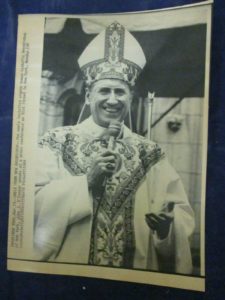
Archbishop O’Connor, 1984
John J. O’Connor, Bishop of Scranton, Pennsylvania, arrived in New York City in January 1984. He was named Archbishop of New York shortly before his installation and made a cardinal by Pope John Paul II in 1985. O’Connor stayed in the news, and in the center of multiple controversies until he died in 2000. He was very passionate about several issues, particularly opposition to abortion and support of organized labor. He also didn’t mince words about lesbian and gay people: no hiring, housing, or civil rights protections. From the start he was a relentless foe of Mayor Edward Koch’s Executive Order 50, a directive which prohibited “agencies that receive city funds from discriminating against homosexuals in employment.”
Although he denied it, O’Connor pressured Francis Mugavero, Bishop of Brooklyn, to shift his diocese’s stance of engagement with gay people to stiff opposition to legal protections. In February 1984 they issued a joint statement in which they claimed that the gay rights bill was “exceedingly dangerous to our society,” explaining, “We believe it is clear that what the bill primarily and ultimately seeks to achieve is the legal approval of homosexual conduct and activity, something that the Catholic Church, and indeed other religious faiths, consider to be morally wrong. Our concern in this regard is heightened by the realization that it is a common perception of the public that whatever is declared legal, by that very fact, becomes morally right.”
Archbishop O’Connor was very clear on his position about homosexuals in the church’s employ–“We have said repeatedly that we have no problem whatsoever in employing people admitting to or not admitting to homosexual inclinations. If an individual avows engagement in homosexual activity, then we want to be able to say whether or not we will employ that person in this particular job, and we feel this is a perfectly appropriate thing for any agency. You know, we have five thousand, seven hundred youngsters in child-care agencies, and they are the ones currently at issue.” O’Connor said it would be wholly alien to Catholic teaching to employ in a child-care agency someone who openly advocated homosexuality.
In September 1984, I was a member of a delegation from the Coalition for Lesbian and Gay Rights (CLGR) who met with Archbishop O’Connor at the New York Catholic Center to discuss Executive Order 50. Terrence Cardinal Cooke, O’Connor’s predecessor, had refused to meet with Dignity/New York to discuss it. Coalition representatives were packed with Catholics, some of whom were members of Dignity and the Conference for Catholic Lesbians (CCL). When we arrived at the building, all in business attire, the guard at the door waved us through saying, “This way, ladies, or whatever…” As we got on the elevator, someone who knew who we were and where we were headed whispered, “Good luck.”
We were ushered into a conference room to wait for Archbishop O’Connor. I had a seat toward the end of the table facing the door. I saw Archbishop O’Connor striding down the corridor towards the meeting room. He was alone; no aides accompanied him. He looked grim. I don’t know what possessed me, but I winked at him. He winked back! We smiled. O’Connor walked into the room and walked around the table shaking everyone’s hand. I thought, “Perhaps there’s hope.” He sat down and the meeting started.
I can’t remember what was said, but all our arguments and personal experiences of ridicule, threats, and rejections by our friends, family, co-workers and faith based on our sexual orientation didn’t affect him. He said something to the effect that the Church would never accept us in the way we wished to live. The table went totally silent. It was a stunning moment; I felt the pain from his statement totally wash over me. I cried. Several other people at the table also cried, including a man who had recently lost his children in a custody battle. I turned to look at Archbishop O’Connor and saw that he looked surprised. He may have thought that our firmness and anger at our Church meant that we hated it or didn’t care. The opposite was true. There was nothing else to say and we left.
A few weeks later, I decided to write him a thank you note for the meeting. I told him I appreciated that he met with us and listened to what we had to say. I also said that while we strongly disagreed, I had respect for him for his straightforward expression of what he believed.
Three weeks later I received a reply to my letter.
Dear Karen:
Your letter…was extraordinarily kind and touched me deeply. I am indeed grateful. It is my sincere hope and prayer that through the years ahead I will be able to serve you in some way that you will consider helpful. My convictions about Church teaching are very deep. I do not anticipate a change in such teachings, and neither do I see it precluding our loving one another as brothers and sisters in Christ.
Please believe that I will give deeply sincere consideration to any recommendations that can help us in that regard in accordance with the tenets of the church which I am certain we both love.
You and your associates are very much in my masses and my prayers, and I ask that you keep me in yours as well.
Faithfully in Christ,
John J. O’Connor
We never spoke, or saw one another again, but the experience of meeting Archbishop O’Connor helped to guide me on how to engage with others with whom I don’t agree:
-Listen to adversaries as well as friends. One discussion may not change any minds, but it will have an impact and it shows a basic respect and courtesy.
-Look for the good in people. See a whole person, not just an opinion or point of view.
-Persevere. The Coalition members at the O’Connor meeting continued the fight for gay and lesbian civil rights. Dignity and CCL continued to work for the respect and recognition of lesbian and gay people in the Church.
On March 20, 1986, the New York City Council passed a homosexual rights bill by an unexpectedly wide margin of 21 to 14. The bill forbade discrimination based on sexual orientation in housing, employment, and public accommodations. The bill did provide an exemption for religious institutions.
The fear that the Archdiocese of New York expressed came true: public protections guaranteed by law did change public perception of lesbian and gay people. The widening acceptance and protection encouraged people to live and love more openly. As more and more gay people came out to their friends, family and colleagues, media portrayals also changed, which encouraged even more people, and younger people, to come out.
In 2013, even the highest level of the Church changed. In response to a question from the news media about a gay priest, Pope Francis made the statement, “Who am I to judge?”
Where is Fr. C. John McCloskey III? For roughly a decade, 1997-2005, the handsome, dashing, charming Opus Dei priest was storming the Beltway in his black soutane. 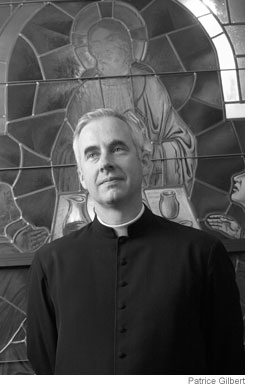
A 1975 graduate of Columbia University, McCloskey was first drawn to Opus Dei when he was a teenager growing up near Washington, D.C. During and after college he worked on Wall Street, leaving in his mid-20s to become a priest. Many of McCloskey’s bios note he is also an avid squash player.
Fr. McCloskey was high-profile, with TV commentator spots, prominent news media quotes, and a string of conversions of powerful men. He was groomed by Opus Dei to do exactly what he did so successfully–befriend Republican political and cultural elites; and articulate an orthodox Catholic point of view. Then, pfft–nothing. Out of sight.
In the years since he left D.C., Fr. McCloskey, 64, has kept a much lower profile. He’s still writing and doing pastoral ministry, but not on a secular stage. McCloskey lives in Menlo Park, California, home of Facebook, Kleiner Perkins, Caufield & Byers, Sequoia Capital, Silver Lake Partners, and many Fintech companies. Perhaps Opus Dei and McCloskey have moved on to the new power elite?
However, the original mystery remains–what happened? Why would Opus Dei transfer Fr. McCloskey out of his Washington, D.C. powerhouse–the Catholic Information Center on K Street–and pack him off to obscurity in Chicago? 
Theory 1: Did he draw too much attention to himself by his high profile converts and media appearances?
Every article about Fr. McCloskey notes with pride his converts to Catholicism. Most are from Jewish and Evangelical Christian backgrounds, with a sprinkling of Episcopalians. “A lot of these men had been thinking about Catholicism before,” McCloskey explained, “and it wasn’t just me per se, but the fact a lot of very smart people–senators and judges–were looking for truth in their lives. It helped quite a bit that many of these men were influenced by men at their level who were Catholics. In a lot of cases, those friends referred them to me. Then the word got out that I was willing to instruct these sorts of people. It’s just like the brokerage business or any other business of sales,” said McCloskey. “You get a reputation, you deal with one person and they mention you to another person and they mention you to another person…and all of a sudden you have a string of people.”
Here are the converts cited most:
. Sam Brownback, former U.S. senator and governor of Kansas; and now United States Ambassador-at-Large for the U.S. Commission on International Religious Freedom,
. Robert Bork, judge and former U.S. Supreme Court nominee,
. Robert Novak, “Crossfire” co-host and columnist,
. Alfred Regnery, conservative book publisher. A revised and updated English edition of The Dictator Pope—a book highly critical of Pope Francis – was released both in hardcover and e-book formats by Regnery Publishing on April 23, 2018.
. Newt Gingrich, political consultant and former minority whip and speaker of the U.S. House of Representatives, and former Republican presidential candidate. His wife, Callista Gingrich, currently serves as U.S. ambassador to the Holy See,
. Lawrence Kudlow, economist and long-time CNBC commentator, now President Trump’s top economic policy advisor,
. Lewis Lehrman, financier and former New York gubernatorial candidate,
. Jeffrey Bell, political consultant and PR guru,
. Maj. General (Ret.) Josiah Bunting III, author, educator, former superintendent of Virginia Military Institute, and currently head of the Henry Frank Guggenheim Foundation,
. Dr. Bernard Nathanson, abortion doctor and one of the founders off the National Abortion Rights Action League,
. Mark Belnick, former Tyco International general counsel.
Two women are occasionally included in this distinguished group:
. Meghan Cox Gurdon, children’s book critic for the Wall Street Journal and Mayflower descendant,
. Laura Ingraham, conservative TV and radio talk show host, author, and Fox News Channel contributor.
Theory 2: Did his emphasis on male friendship as an evangelization tool fall flat? 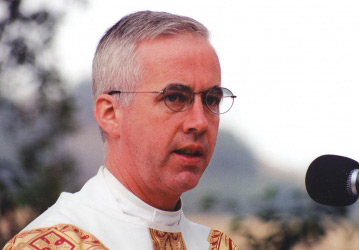
In his 2007 book with Russell Shaw, Good News, Bad News: Evangelization, Conversion and the Crisis of Faith, Fr. McCoskey described his theory about American men–they lost the ability to maintain “virile” male friendships. They were victims of a “Friendship Deficit Syndrome.” In another article, Friendship: The Key to Evangelization of Men, McCloskey described a group of Italian men at lunch in Rome, drinking “vino russo” and having a good time together. “I got the impression that this was not a singular event but rather one of frequent meetings of long-time close friends. For some reason it seemed strange to me, and at the same time appealing.”
McCloskey elaborated, “…in the U.S., men got together to watch sports on TV or in a bar, drank beer instead of wine, ate stacked sandwiches instead of pasta. “More often than not, they are enjoying not each other but the game.” “As things stand today, for many Catholic men “friendship” can mean a largely artificial tie, based on a common interest in beer, cars, sports, hunting, fishing, or even an unhealthy interest in the pursuit of young women. (In fact, I hesitate to use the word “friendship” to describe this relationship; would “acquaintance” be a better term?) A real male relationship is a deep and lasting bond that goes to the very core of what a man is or can be.”
McCloskey blames several things for the lack of male friendships: the loss of exclusively male clubs and schools, moving due to job changes, working women who want their husband’s help, leaving no time for men to socialize together; and finally, “gay culture.” “To complicate matters still further,” said McCloskey, “in today’s society many male relationships are openly homosexual, based on the use of each other as objects of pleasure. Many forms of public entertainment–films, television and the theater–have accepted homosexuality as normal, and begun to portray heterosexual males as fools who live under the sway of domineering women. One of the many unhappy side-effects of this open public perversion,” he goes on, “is the fact that when any small group of adult males is seen together, at least in some urban centers, they are assumed to be homosexual.”
After reading this article, which made a point to disparage traditional male pastimes of hunting, fishing, watching sports and chasing women–I tried to image my father’s reaction: “What would you expect from a priest?” he would have chuckled, with a twinkle in his ex-Marine, Irish eyes. As for people thinking he was a fairy because he was out with a couple of buddies, well, dad wouldn’t have taken that seriously. I would suggest that only closeted, self-loathing homosexuals would be anxious about being perceived as gay. It wouldn’t occur to my father or most heterosexuals to even think about it.
A goal of evangelical friendship is conversion. The use of friendship in a conversion process walks a very fine line between support and manipulation. Men who feel guilty about past acts; men in a mid-life crisis; the lost and lonely are especially vulnerable. Do most men feel they don’t spend enough time with other men? I don’t know. I value women-only activities, dinner parties and events but don’t associate them with my spiritual needs. My social needs–yes, but I’m a lesbian.
Theory 3: His article fantasizing a U.S. religious civil war made people uneasy about him.
In 2000, Fr. McCloskey published a long essay in the Catholic World Report entitled “2030: Looking Backward.” It is a fictional piece in which his alter ego, Fr. Charles, a 77-year-old priest writes a January 1, 2030 letter to Fr. Joseph, a 25-year-old priest, reflecting on the recent breakup in the the United States and the emergence of the Regional States of North America.
In his essay, McCloskey foresees a smaller Catholic Church in the future. “…the Catholics we do have are better formed, practice their Faith in the traditional sense at a much higher level than ever, and are increasingly eager to share that Faith with their neighbors. Dissent has disappeared from the theological vocabulary.” In addition, hundreds of thousands of Evangelical Protestants convert to Catholicism. 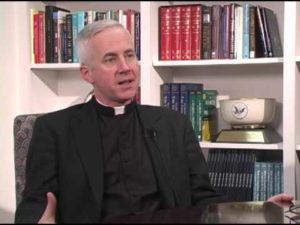
It sounds like the wishful thinking of a strident, thwarted, orthodox Catholic. In 2000, in spite of the 21-year reign of doctrinaire Pope John Paul II, moderate and liberal Catholics kept a tenacious grip to their faith. American Catholicism continues to be messy, contentious and organic as different groups within the Church jockey with one another on what it means to be Catholic, and how best to live their faith between the Gospels, the Magisterium and American democratic ideals and culture.
The most controversial paragraph in the essay was the one where Fr. McCloskey appeared to encourage the breaking apart of the union, and the development of Christian-governed states. As part of the reconstitution of the U.S., he appears to sanction the deaths of many thousands of people.
As he put it, “We finally received as a gift from God what had been missing from our ecclesial experience in these 250 years in North America–a strong persecution that was a true purification for our “sick society.” The tens of thousands of martyrs and confessors for the Faith in North America were indeed the “seed of the Church” as they were in pre-Edict of Milan Christianity. The final short and relatively bloodless conflict produced our Regional States of North America. The outcome was by no means an ideal solution but it does allow Christians to live in states that recognize natural law and divine Revelation, the right of free practice of religion, and laws on marriage, family, and life that recognize the primacy of our Faith.”
McCloskey acknowledged “A goodly number of faithful Catholic writers also found it dark and threatening, although I had intended it to be positive and optimistic.” Would the politicians, elected officials and other prominent people that McCloskey consorted with feel the same way? Probably not. In the hands of secular media it could be framed as a fanatic’s call to sedition and violence.
Fr. McCloskey did make some accurate predictions in his essay, including the regional splits of “red states” and “blue states”; and the affinity between Evangelical Christians and ultra conservative Catholics on many political issues. This coalition supported Republican party candidates in exchange for their votes on abortion, homosexual civil rights protections, same-sex marriage, religious liberty/conscience rights and federal funding for their institutions.
He also articulated the struggle between Catholicism and secular society. There is an eerie parallel with McCloskey’s essay and the dystopian novel, Lord of the World. This obscure, apocalyptic book was written in 1907 by Monsignor Hugh Benson, an Anglican convert to Catholicism. 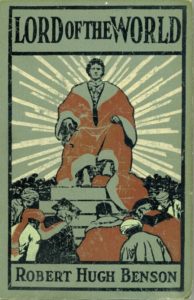
It imagines a socialist, humanistic and technologically advanced world where religion has been rejected or suppressed. It is a story about the Antichrist and End Times–the product of a struggle between a radically secular society and the one alternative to it–the Catholic Church. Most religious leaders have been co-opted by humanist ideals. Belief in God is replaced by belief in man. Only a small remnant of the Catholic faithful remain. To a certain point of view, this is a chillingly accurate depiction of our present states.
What would Fr. McCloskey’s alter ego, Fr. Charles, say now if he could look back at what’s happened in the years since 2000?
What would he say about the sexual abuse holocaust that engulfed the global church and continues unabated to this day? A month doesn’t go by without another cardinal, bishop, church official or priest getting dragged into court, or the court of public opinion. What are his thoughts on Pope Benedict XVI, the former Joseph Cardinal Ratzinger, who became the first pope in almost 600 years to step down from the papacy. What horror did Pope Benedict see that caused him to give up and quit? His resignation ended the reign of four decades of conservative popes, and their “reform of the reform” of Vatican II. Springtime arrived, but it was for liberal and progressive Catholics… Could Fr. Charles ever have envisioned what would follow after Jorge Cardinal Bergoglio of Argentina was elected Pope Francis in 2013? In his wildest dreams, could he imagine a pope saying, “Who am I to judge?”






